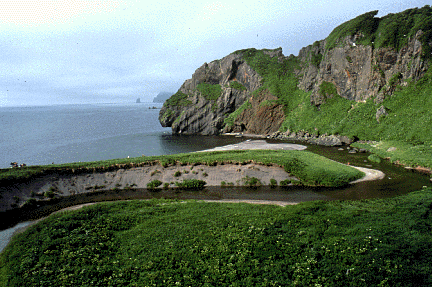
![]()
![]()
Project Schedule |
 Assuming
funds can be made available by May 1995, a series of five annual
expeditions will take place in August and September of each year of
funding. In 1995, we will collect on Urup, Simushir, Ketoi, and Rasshua
(a total of seven transects); 1996, Matua, Shiashkotan, Ekarma,
Kharimkotan, and Onekotan (seven transects); and 1997, Makanrushi,
Paramushir, Shumshu, and Alaid (six transects). In 1998, we will collect
on the southern tip of Kamchatka; although not part of the Kuril
Archipelago, comparative information from this region, an important
source biota for the islands, is crucial to our study (seven transects).
In 1999, we will return to the southern group of islands: Kunashir,
Iturup, Shikotan, and Zelionyi (seven transects). Although we made large
collections on all four southern islands in 1994, only 31 actual field
days were available to us, many of the numerous available habitats were
inadequately surveyed, and major taxa were not collected (e.g., plants);
it is thus crucial that we go back to these islands, the most biologically
diverse of the chain. Assuming
funds can be made available by May 1995, a series of five annual
expeditions will take place in August and September of each year of
funding. In 1995, we will collect on Urup, Simushir, Ketoi, and Rasshua
(a total of seven transects); 1996, Matua, Shiashkotan, Ekarma,
Kharimkotan, and Onekotan (seven transects); and 1997, Makanrushi,
Paramushir, Shumshu, and Alaid (six transects). In 1998, we will collect
on the southern tip of Kamchatka; although not part of the Kuril
Archipelago, comparative information from this region, an important
source biota for the islands, is crucial to our study (seven transects).
In 1999, we will return to the southern group of islands: Kunashir,
Iturup, Shikotan, and Zelionyi (seven transects). Although we made large
collections on all four southern islands in 1994, only 31 actual field
days were available to us, many of the numerous available habitats were
inadequately surveyed, and major taxa were not collected (e.g., plants);
it is thus crucial that we go back to these islands, the most biologically
diverse of the chain.
|
 The Obzhitaya River at its mouth in Natalii Bay, Urup Island.
|
 Following each
annual expedition, all members of the international team will spend an
additional week (or however long it takes) at the Usujiri Biological
Station, Hokkaido, sorting, identifying, curating, and preparing
specimens for shipment to the appropriate institution; during this time, we
will also complete the task of entering all field data into the locality
database. The intervening fall, winter, and spring of each project year
will be devoted to additional curation and identification, assembling the
taxonomic database, making the database and specimens widely available,
preparing checklists and keys, and planning for the next field season.
Following the fifth and final expedition, every effort will be made to
complete the production of keys, guides, and annotated checklists prior
to the termination of the grant in May 2000. Following each
annual expedition, all members of the international team will spend an
additional week (or however long it takes) at the Usujiri Biological
Station, Hokkaido, sorting, identifying, curating, and preparing
specimens for shipment to the appropriate institution; during this time, we
will also complete the task of entering all field data into the locality
database. The intervening fall, winter, and spring of each project year
will be devoted to additional curation and identification, assembling the
taxonomic database, making the database and specimens widely available,
preparing checklists and keys, and planning for the next field season.
Following the fifth and final expedition, every effort will be made to
complete the production of keys, guides, and annotated checklists prior
to the termination of the grant in May 2000.
|
![]()